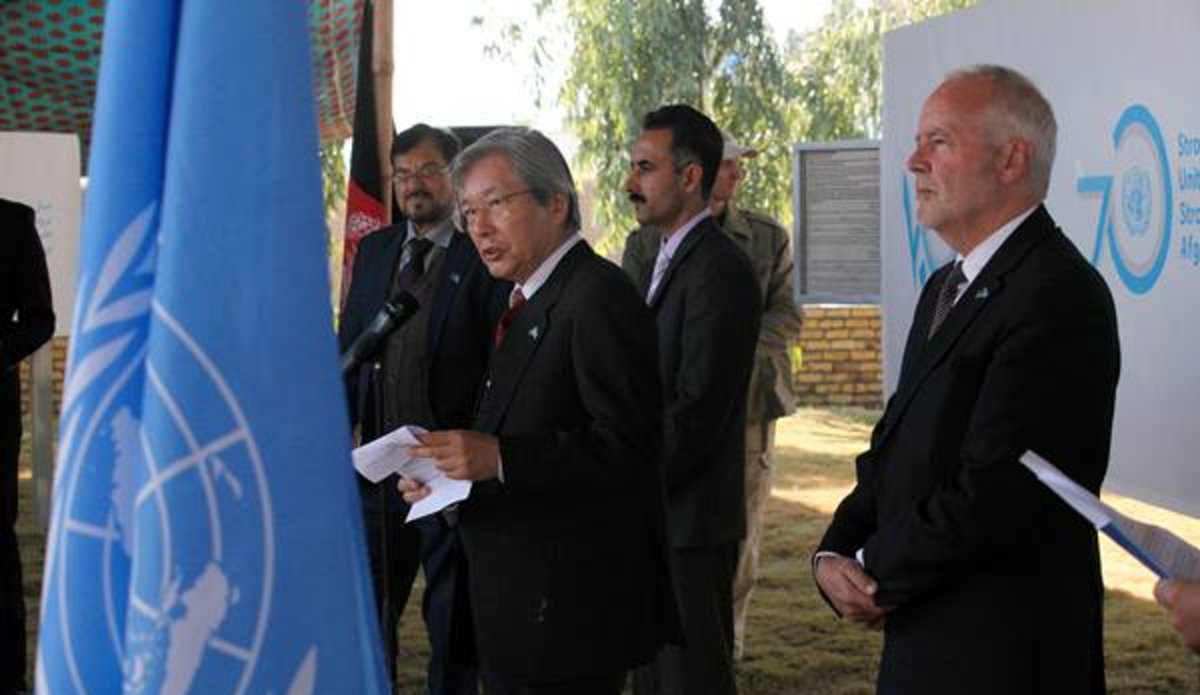UN70 event in Kandahar celebrates enduring partnership with Afghans
KANDAHAR - Government leaders, civil society representatives and community elders joined with United Nations officials in Kandahar to celebrate the enduring Afghan-UN partnership.
Abdul Ali Shamsi, the Deputy Governor of the southern province, and Tadamichi Yamamoto, the UN Secretary-General’s Deputy Special Representative for Afghanistan, spoke at the event, the centrepiece of which was a photography exhibition highlighting the work and achievements of a group of Afghan professionals.
“We are proud to celebrate 70 years of the UN’s existence with our friends, our partners, our close collaborators,” said Mr. Yamamoto, who spoke about the work of the organization in Kandahar and the current challenges facing the world body and its partners in the region.
“Afghanistan, especially, is a case in which we can both record achievements but in which we must face serious challenges ahead,” said the UN envoy.
“Some of our staff and colleagues, to whom I pay tribute today, paid the highest sacrifice,” said Mr. Yamamoto. “Here I pay homage to our fallen colleague Toorpeki Ulfat who was murdered in this city last month.”
Mr. Yamamoto accompanied the Deputy Governor during the exhibition, talking about each of the photographs that display the work of Afghans making a difference for the future of the country.
“The question arose for us how best to celebrate the special relationship between the United Nations and Afghanistan, and how best to celebrate the ideals which drive the organization,” said Mr. Yamamoto. “We have decided, instead of listing the achievements of the United Nations, to focus on the work of a group of Afghan citizens.”
It is their work, said the UN envoy, that best represents the ideals of the United Nations. Mr. Yamamoto explained that the Afghan professionals were selected for the exhibit not only because they represent the diversity of Afghanistan, but also because they represent the full range of activities in which the United Nations has been engaged.
“Whether it is the protection of human rights, the preservation of cultural heritage, promotion of the environment, mobilization of youth, promotion of educational opportunity, or in creating safer conditions for communities to live, by, for example, clearing landmines – their work is a credit to them and to Afghanistan,” said Mr. Yamamoto.
Mr. Shamsi spoke at length about the positive contributions the United Nations has been making in Afghanistan, and in particular in Kandahar and the southern region of the country through various projects and programmes, from improving education and healthcare to making drinking water potable and helping eradicate landmines.
He also talked about the UN’s work with refugees and in helping to improve the security situation across the province.
“The activities and projects of the United Nations are admirable in Kandahar,” he said, noting that the region continues to need the assistance of the world body, especially in agriculture, higher education, healthcare and development, and also in peace and security.
“We must protect the achievements that the UN and the government have made over the past 14 years,” he stressed, expressing appreciation to those who have helped work to improve the lives of the people of Kandahar.
Around 60 people attended the event, which brought together a series of specially commissioned panoramic photographs. Each photo – measuring four metres wide – contains three main scenes, highlighting key aspects of the professionals’ work in areas such as improved healthcare, support for returning refugees and environmental protection.
The touring UN70 exhibition has drawn audiences of government officials, diplomats and community leaders in Kabul, Mazar-e-Sharif, Jalalabad and Herat. Billboards celebrating the UN’s 70th anniversary – including messages about key work done by the UN family in Afghanistan – have gone up in Kandahar, following their initial release in Kabul and other cities around Afghanistan.
The nine panoramic photographs featured in the exhibition, along with the profiles of the outstanding professionals whose work is depicted in them, are available for viewing on UNAfghanistan.org
 UN
UN







